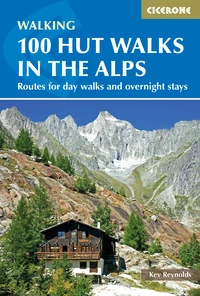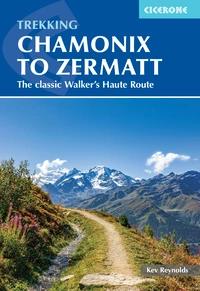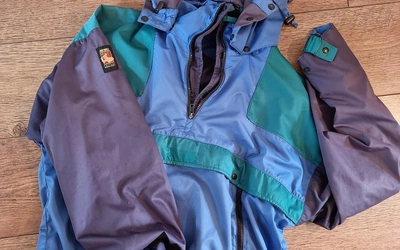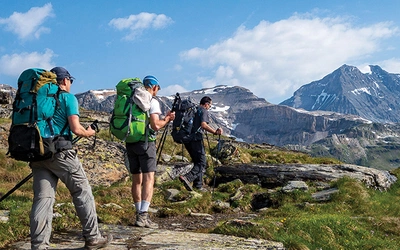Everything you need to know about staying in a mountain hut
Refuge, cabane, rifugio or hütte... mountain huts are a great way to stay high in the mountains, but the thought of planning an alpine trek can be daunting. Will the huts be open and manned? How do I book? What facilities are there? How much will it cost? Here, Kev Reynolds' expert advice covers everything you need to know about the mountain hut experience.
The Mountain Hut Book
£14.95
An introduction to mountain huts and refuges for walkers and trekkers. Informative and entertaining, this book explores the mountain hut experience, from how huts have developed to modern-day hut etiquette. With profiles of the author's top picks, and the best hut-to-hut routes in the Alps and Pyrenees.
More informationWhat is a mountain hut?
A mountain hut is a purpose-built refuge situated at some strategically high place in the mountains, often situated so that one or more peaks are readily accessible from it. It may vary from a simple bivouac shelter to something resembling a small hotel in size and facilities.
Most are staffed during the main summer season, which usually extends from mid or late June until the end of September – opening dates depend on location, altitude and, in some cases, the depth of the previous winter’s snow – while some are also open for a few weeks in the late winter/spring ski-touring season. When manned, meals and drinks will be on offer; but off-season, when there’s no warden in residence, there will often be a ‘winter room’ available, containing little more than a few basic necessities like bunks, blankets and perhaps a wood-burning stove and a supply of fuel.
There are also those simple unguarded refuges, usually located in a remote district, where facilities are minimal and you need to carry practically everything with you, including stove, fuel and food.
Do I need to book in advance?
Advance booking is essential if you wish to stay in a popular region during the high season, and it is becoming increasingly common for some huts to be fully booked several weeks or even months ahead – those in national parks and the Mont Blanc range, for example. It is best to contact the hut (phone or email) at least a day or two before your planned arrival, as it gives the staff an idea of how many to cater for, and gives you confirmation that there will be space available for you when you arrive.
The busiest times are in the high season and at weekends, especially if the hut is easily accessible, and during periods of fine weather, when climbers may seize opportunities to go high. When a hut is completely full, the warden may allocate emergency sleeping places if, say, there’s no time for a new arrival to reach alternative shelter, or in cases of extreme bad weather. In such cases, a dormitory floor, a passageway or even the space beneath a table in the dining room may be used as a bed. Some wardens deal with the prospect of overcrowding by providing overflow accommodation in an annexe which may, or may not, consist of a conventional building with four walls and a roof!
Make sure you arrive in good time for the evening meal, and call ahead if you are likely to be late. If your plans have to change and you need to stay elsewhere, phone the hut as soon as possible to cancel your booking. If the hut was going to be full for that night, other walkers or climbers may be turned away unnecessarily – and the hut keeper loses income. In extreme cases, it may lead to the mountain rescue being called out to search for you.
How much does a mountain hut cost per night?
For one person, the cost of half board in a dormitory is likely to cost between 60-80 euros per night. If you are a couple you may find the price for a double room (if available) is only a little more expensive, and much more comfortable. Small groups of four or six can usually book a suitable size dormitory and often avoid the need to share. You will need to pay for all extras – drinks and snacks are likely to be more expensive than they would be in the valley.
What happens when I arrive?
It's almost time to relax – but first, have a wash or shower and change. Do any laundry and other chores, and get your bunk and kit sorted while it is still daylight and you can see easily. After that, the rest of the afternoon and evening is free for chatting to other trekkers, enjoying snacks or maybe a beer or some wine, studying the map and guidebook for the following day, or just relaxing and enjoying the view. You will have earned it!
What sort of meals should I expect?
Well, perhaps not haute cuisine, except in its most literal sense. Mountain activities burn a lot of calories, so hut meals are usually planned with this in mind, with plenty
of carbohydrate such as pasta being served. Meals are usually served at large communal tables, with individual places allocated by the guardian. These mealtimes tend to be enjoyable and sometimes noisy occasions with an opportunity for visitors to get to know one another; when extra busy, two separate sittings may be needed. Jugs of drinking water are provided, and beer and wine are usually available to buy separately.
Given advance warning, vegetarians can be catered for, and other special diets can be accommodated if possible. However, expectations should not be raised too high as the simplest option will often be taken by the hut staff. High huts get their supplies delivered by costly helicopter – in some cases perhaps just once or twice in a three-month season – or on the back of a mule or by a basic goods lift or even at least partially on foot, so the variety and freshness of ingredients may be somewhat limited. Generally, a meal will consist of soup, a main course usually of a meat dish (usually stew or casserole, carbohydrate (pasta/potato/polenta/rice), and a simple dessert. Fresh vegetables and salads are a treat in high huts but are usually more readily offered if the hut is easily accessible.
If ordered the night before, packed lunches (usually a sandwich, snack, energy bar/cake, and a drink) or just a sandwich can usually be arranged. Breakfast is often scheduled according to the needs and chosen routes of those staying overnight, so one breakfast sitting may be at 4 am, while another will be served two or three hours later. Breakfast will consist of cereal and bread with jam/Nutella, washed down with tea/coffee/hot chocolate. More accessible huts may offer a few more options.
Are drinks available?
Canned or bottled drinks are on sale in virtually every staffed hut, although prices are invariably higher than you’d pay in the valleys. Beer and wine are nearly always available, as well as stronger 'grappa' and liqueurs – usually the local (powerful) concoctions! You might want to bring a supply of tea bags or coffee sachets then ask for hot water to make up your own drinks. Some Austrian and Swiss huts will provide a supply of Marschtee (usually sweetened fruit tea) with which to fill your flask before leaving, at no extra cost. In some high huts fresh drinking water may be unavailable, so you will need to buy bottled water.
What are the sleeping arrangements?
Most huts have mixed-sex dormitories but, for an additional fee, some do have private bedrooms with two, four or six bunks. Two-bed rooms for couples often don't cost a great deal more per person and are much more restful. Even dormitories vary, not only in size, but in the type of sleeping arrangement on offer. The traditional dortoir or matratzenlager – a ‘mattress room’ – is a large communal space with a row of anything from 8 to 30 mattresses laid side by side. These are still found in some huts, but the trend now is for smaller, more conventional dorms with two-tiered bunk beds. Either way, take ear plugs, especially if you are a light sleeper!
Pillows and duvets or blankets are provided, but you must use your own sheet sleeping bag or rent one from the hut. Keep a head torch handy, as lights are usually turned off shortly after 9pm.
What about bathroom facilities?
Bathroom facilities vary greatly, are always shared, but often segregated into single-sex. The best will have hot showers (mostly coin- or token-operated) and plentiful running water. Although seldom sufficient to serve the number of visitors, toilets in these ‘valley huts’ will be as good as those found in modest hotels, but the higher the hut, the more basic or primitive the toilets are likely to be, and more limited the opportunities for washing. There are exceptions, of course, and standards are improving year by year. Solar panels often provide the sole source of electricity in high huts, so on dull days there may be insufficient to heat water for hot showers – be warned, but embrace the opportunity for a cold refreshing wash!
There may be separate facilities for clothes washing, otherwise dumping everything on the floor of the shower will get you a long way towards clean washing. There's often a line, or a fence or even some warm rocks on which to dry everything.
Will there be Wi-Fi and charging points?
Many huts now have Wi-Fi access but don’t automatically assume that this is the case. Most, but not all huts, have power sockets to charge mobile phones or other portable electronic devices, so plan your needs accordingly. It's best to prioritise charging your phone first, then any other items if there is an opportunity.
Is there specific hut etiquette?
- Leave boots, trekking poles and wet outer clothing in the boot room or porch
The first thing to do before you enter the main building is remove your outdoor boots/shoes and place them along with your trekking poles on one of the racks you’ll find in the boot room or entrance porch. There will often be a supply of ‘hut shoes’ to change into. They could be Croc-style shoes, floppy old mules or even old-fashioned clogs, all of which will be available in various sizes. If you don’t fancy these, pack your own lightweight slippers or sandals to wear inside the building. But don’t risk upsetting the warden by clomping through the hut in your walking boots, and if outer clothing is wet, hang waterproofs from racks in the boot room or, if there’s a drying room, leave them there.
- Check in with the hut keeper/guardian
You don’t have to be a member of an Alpine Club to stay in a mountain hut, as the vast majority are open to all-comers, whether privately owned or belonging to one of the national mountaineering organisations. If you have an alpine club membership card or a reciprocal rights card (such as a BMC or Austrian Alpine Club), show this on arrival to claim a discount on overnight fees.
When you check in, book meals and any packed lunches required for the next day. If you have dietary requirements, make these known as early as possible.
The guardian will probably outline any house rules, and may ask you to sign a visitors’ book (the Hut Book), which keeps a log of where you came from and where you’re going next day.
- Be considerate of others and avoid unnecessary noise in the dormitories.
Guardians will often enforce a silent period between 10pm and 6am to limit disturbance by the early risers – especially in high mountain huts inhabited by climbers, where the most ambitious are likely to be up and away long before 6am or, at the very least, an hour or more before dawn. The best way to keep noise down is to organise your belongings neatly the night before to minimise the risk of forgetting or not seeing small items. Use stuff sacs to organise your kit, and avoid using carrier bags – they make an incredible racket when you are rummaging inside!
- Pay for all services in the evening
In most huts, you will be asked to settle your bill the night before you leave. Although it's usually possible to pay with credit and debit cards, some huts have insufficient signal to take payment this way, so you should always ensure you have sufficient cash. Finally, leave your room or bunk tidy by folding blankets or duvets, and take all litter away with you. Make sure you have all your belongings – it's easy to lose or forget small items, especially when the dorm is busy with everyone moving around and trying to pack up. Items such as head torch, toothpaste, phone charger, and even washing on the line can easily be missed, and remember to pick up your sandwich or lunch if you ordered something. Taking a few extra minutes before heading off is time worth spending!
Databases of mountain huts across the Alps:
Club Arc Alpin: This site provides links to alpine club sites with hut databases for France, Germany, Italy, Switzerland, Austria and Slovenia
Direct links:
Swiss Alpine Club huts
French Alpine Club huts
Italian Alpine Club huts
Austrian Alpine Club huts













